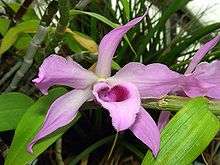Dendrobium anosmum
| Unscented dendrobium | |
|---|---|
 | |
| Scientific classification | |
| Kingdom: | Plantae |
| (unranked): | Angiosperms |
| (unranked): | Monocots |
| Order: | Asparagales |
| Family: | Orchidaceae |
| Subfamily: | Epidendroideae |
| Tribe: | Dendrobieae |
| Subtribe: | Dendrobiinae |
| Genus: | Dendrobium |
| Species: | D. anosmum |
| Binomial name | |
| Dendrobium anosmum Lindl. (1845) | |
| Synonyms[1] | |
| |
Dendrobium anosmum (unscented dendrobium) is a species of epiphytic orchid. It is widespread across Southeast Asia from Sri Lanka to New Guinea, including Indochina, Indonesia, the Philippines, etc.[1] In 1839, the scented variety was first discovered by Lindley in the Philippines and named Dendrobium macrophyllum, which later on considered as homonym of other species. Six years later, the unscented variety was discovered again in the Philippines, hence, the botanical nomenclature until to this date.
In the Philippines, it is locally known as Sanggumay, a coined Tagalog term for masangsang (overpowering scent) and nakakaumay (tiresome). Other local term includes Latigo (horsewhip) referring to its long pendulous canes which became deciduous before flowering.
References
External links
- Dendrobium Superbum (Photos).
 Media related to Dendrobium anosmum at Wikimedia Commons
Media related to Dendrobium anosmum at Wikimedia Commons Data related to Dendrobium anosmum at Wikispecies
Data related to Dendrobium anosmum at Wikispecies